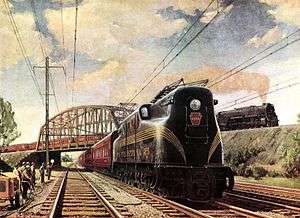PRR J1
|
J1 locomotive (upper right) hauling freight on the PRR's low-grade line in 1949 | |||||||||||||||||||||||||||||||||
| |||||||||||||||||||||||||||||||||
| |||||||||||||||||||||||||||||||||
| |||||||||||||||||||||||||||||||||
| |||||||||||||||||||||||||||||||||
The PRR J1 was a class of 2-10-4 or "Texas" type steam locomotives with 69 in (180 cm) driving wheels built between 1943 and 1944. The J1 had over 95,000 pounds-force (422.6 kN) of tractive effort, plus an additional 15,000 lbf (66.7 kN) if the booster engine was used.
Features
As with many of the Pennsylvania Railroad's steam locomotives, the J1 had its headlight above the smokebox. Like the M1 the J1 had a keystone numberplate, unlike the round numberplates seen on the rest of the PRR's freight steam locomotives. They were also equipped with Baker valve gear instead of Walschaerts valve gear which was more common on the PRR. Additionally, they had radial-stay fireboxes instead of the Belpaire fireboxes seen on nearly all of the Pennsylvania Railroad's steam locomotives. Mechanically, these locomotives were identical to the C&O's T-1 class 2-10-4s.
History
During World War II the Pennsylvania Railroad needed heavier locomotives to pull freight and military equipment, but wartime restrictions prohibited the development of a new locomotive design. In response to this the Pennsylvania Railroad borrowed a 2-6-6-4 Class A of the Norfolk & Western Railway and a 2-10-4 from the Chesapeake and Ohio Railroad. Both locomotives underwent extensive testing, with the C&O 2-10-4 chosen to be produced. A total of 125 were built at PRR's shops in Juniata, Pennsylvania. They came to be known as the PRR's "War Babies," but the J1's remained in service into the 1950s. When the Pennsylvania Railroad converted from steam power to diesel, the PRR scrapped most of them in 1958 with the exception of 25. The remaining 25 were scrapped in 1959.
